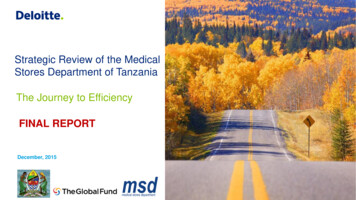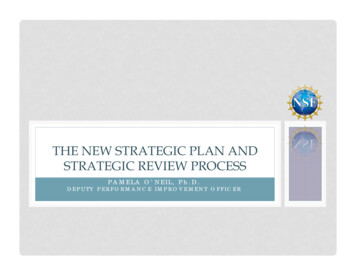
Transcription
Strategic Review of the MedicalStores Department of TanzaniaThe Journey to EfficiencyFINAL REPORTDecember, 2015Strategic Review of MSD
Glossary of termsAbbreviationLong FormAbbreviationLong FormAPSAdvanced Planning SchedulingDPTWMDemand Planning Technical Working ManualAPPAnnual Procurement PlanDPUDemand Planning UnitAWBAirway BillDPsDevelopment PartnersAFSAnalysisPeriodAGAudited Financial StatementsE9Epicor 9E10Epicor 10Attorney GeneraleLMISElectronic Logistics Management Information SystemATSAnnual Technical SupportEMTExecutive Management TeamBoTBank of TanzaniaERPEnterprise Resource PlanningBRNBig Results NowEPIExpanded Program on ImmunizationBnBillionEPMEnterprise Performance ManagementCMSCentral Medical StoreFYFinancial YearCVRClassification & Verification ReportGDPGross Domestic ProductCAPEXCapital ExpenditureGoTGovernment of TanzaniaCMAChief Management AccountantGRNGoods Received NoteCAGRCompounded Annual Growth RateGNIGross National IncomeCRMCustomer Relationship ManagementHIVHuman Immunodeficiency VirusCHFCommunity Health FundsHFsHealth FacilitiesDCSZODirector of Customer Services and Zonal OperationsHCMHuman Capital ManagementDGDirector GeneralIDFImport Declaration FormDHRADirector of Human Resources and AdministrationIDsIdentification CardsDFPDirector of Finance and PlanningILSIntegrated Logistics SystemDLDOSDirector of LegalDormant, Obsolete and Slow movingICDICTInward Container DepotInformation Communication TechnologyDoSODays of Stock OutJSIJohn Snow IncDPMDPDemand Planning ManagerDirector of ProcurementKEMSAKenya Medical Supplies AuthorityKThousandsDMODistrict Medical OfficerKPIKey Performance IndicatorsPeriod starting 1 July 2012 to 30 June 2015Strategic Review of MSD22
Glossary of termsAbbreviationLong FormAbbreviationLong FormLoBLines of BusinessPSPermanent SecretaryLPOLocal Purchase OrderPMO RALGPrime Ministers Office – Regional Administration and Local GovernmentLGALocal Government AuthorityPPMPooled Procurement MechanismLCLetter of CreditQAQuality AssuranceLMULogistics Management UnitSBUStrategic Business UnitsMoUMemorandum of UnderstandingSKUStock Keeping UnitMSDMedical Stores DepartmentSLAsService Level AgreementsmMillionsSOPStandard Operating ProceduresMDGsMillennium Development GoalsSTGStandard treatment GuidelinesMTSPMedium Term Strategic PlanSCSupply ChainMoFMinistry of FinanceSLAService Level AgreementMoHSWMinistry of Health and Social WelfareTFDATanzania Food and Drug AuthorityMSLMedical Stores LimitedTISCANTanzania Inspection Service CompanyMSOMedical Stores OfficeTPATanzania Ports AuthorityNEMLTNational Essential Medicines List for TanzaniaTRATanzania Revenue AuthorityNHIFNational Health Insurance FundTZSTanzania ShillingNMSNational Medical StoresTBTuberculosisO&SPOperations & Sales PlanningUCUnderpinning ContractsOLASOperating Level AgreementsVATValue Added TaxPCVRPHCProvisional Classification & Verification ReportPrimary Health CareVPWCVertical ProgrammeWorking CapitalPHFPrimary Health FacilitiesWGPWarehouse Goods PracticePMUPOProcurement Management UnitPurchase OrderWIBYoYWarehouse in a BoxYear on YearPPAPublic Procurement ActZMZonal managersPPRAPublic Procurement Regulatory AuthorityZTAZonal Transfer AdvicePMPerformance ManagementZTOZonal Transfer OutStrategic Review of MSD3
AcknowledgementDeloitte would like to express sincere thanks to all who made this study possible. Special thanks go to TheGlobal Fund for entrusting us with this important assignment, and for their support throughout. We also wish toextend our sincere gratitude to all stakeholders who in one way or another have contributed to the successfulcompletion of this assignment including: MSD Management and Board of Trustee; Ministry of Health andSocial Welfare; Ministry of Finance; Development Partners Group; President’s Delivery Bureau; EGovernment Agency; The Project Steering Committee Team; MSD Clients and MSD Suppliers. Lastly, to themany Deloitte staff who worked tirelessly to deliver this report.Strategic Review of MSD4
ContentsExecutive SummaryPage 5 - 21Goal of the AssignmentPage 24Approach and MethodologyPage 26 - 28Background InformationMacroeconomic AssessmentPage 30- 36Key TrendsPage 38 - 39MSD SuccessesPage 41Findings and RecommendationsGovernancePage 45 - 53Supply ChainPage 55 - 71FinancePage 73 - 104TechnologyPage 106 – 113PeoplePage 116 - 133High-Level Operating ModelPage 135Proposed KPIsPage 137Implementation roadmapPage 139 - 143AppendixPage 145 - 162Strategic Review of MSD5
With Health being one of the top priority sectors for the Government, the increasing coverage ofinterventions has led to increased demand for health care services thereby creating pressure on MSD toadequately deliver accessible, timely, affordable and quality health care commodities. However, thedeclining trend in Government funding for health care commodities, growing receivables, and operationalinefficiencies have resulted into severe working capital erosion at MSD, further jeopardizing its ability todeliver. This has contributed to instances of stock outs at MSD, translating into unmet health caredemand for the Tanzanian community; calling for immediate structural and operational reforms at MSDand Government level to reinstate MSD’s operational efficiency and optimize service delivery. This reformwill be inline with the current Government’s initiatives of improving operational efficiency and avoidingwaste.Such reforms have happened in similar institutions in several countries and helped transform the healthcare delivery in those countries. A good example is the recent reform of the Kenya Medical SuppliesAuthority (KEMSA). KEMSA's operations have changed from previous status, where the organizationdepended on funds from the government to procure, to the current model where the Authority uses itsown capital to buy medical commodities.Strategic Review of MSD6
Scope of WorkDeloitte was requested to conduct a strategic review of MSD with a focus on the organizations existing governanceframework, supply chain operations, financial performance and the causes for its working capital erosion. We set outbelow the scope of work for the review:BoardComposition1.Understand governance structures at MSD and explore opportunities for improvement including having stronger financial managementcapabilities at MSD board.SeeSlide 10Details on47 - 53LegalStructure2.Provide options for the governance structure required to ensure maintenance of the new fee structure taking into account the possibility tomaintain the current structure or to change into an Agency.SeeSlide 10Details on46 - 49OperationalEfficiency3.Propose efficient business models for the CMS building on the existing work, looking operations of the CMS and from areas of efficiencyimprovement observed from the understanding of the root causes of the challenges currently experiencedSeeSlide 12Details on61 – 69 &1354.Develop KPIs (dashboard) that can provide a comprehensive but succinct picture of financial flows in MSD’s supply chain to MOHSW,Finance Ministry, MSD’s Board of Trustees and development partnersSeeSlide 18Details on137PaymentArrears5.Establish the levels and sources of payment arrears at MSD. More specifically determine the age, institution, type of payment, and reasonfor arrear/receivable.SeeSlide 15Details on94 - 98Options to ClearReceivable6.Propose different options for clearing the current stock of receivables at MSD. In consultation with different stakeholders assess thefeasibility of each of the options.SeeSlide 16Details on98Working CapitalErosion7.Based on above analysis identify the root causes for accumulation of debt and working capital erosion at MSD.SeeSlide 15Details on93 – 94 &102Short TermRecommendations8.Develop specific short term recommendations for preventing the recurrence or further escalation of this problem.SeeSlide 19Details on99 - 1009.Build upon the costing study carried out by USAID to recommend an optimal/sustainable fee structure for MSD based on an efficient systemof operations.SeeSlide 14Details on85 - 91SeeSlide 17Details on73- et FormulationProcessStrategic Review of MSD10. Understand MSD budget formulation process and assess opportunities for improvement. Also study cash management practices at MSDand explore opportunities for improvement.7
Key FindingsOur findings revealed that an inadequate governance framework, operational inefficiencies, inadequate fundingweak performance management and technological challenges have contributed towards the significant workingcapital erosion at MSD1: Inadequate Governance frameworkMSD’s autonomy is limited because of its limited powers inmaking its own strategic decision to operate commerciallyimpacting its financial independence. Lack of the right skill setwithin the current Board also impacts MSD’s ability to improvestrategic performance on its core business. For example, thecurrent Board of Trustees does not have members with experiencein Logistics and supply chain, Pharmaceuticals, andAccounting/Finance which are key to MSD’s core business.2: Operational inefficiencyDespite an average stock out rate of 24% for essentialitems, the value of expired goods has grown by 37%over the past 1year. In addition the Dormant, Obsoleteand Slow Moving (DOS) items grew by 136% over thesame period. As at June 2015, the MSD had over 11.7Bnworth of expired and DOS stock stored in its warehouse.3: Inadequate fundingWhile demand for medicine has been growing at anaverage of 46.7% for the past 4 years, funding formedicine and medicine supplies has been decliningat an average of 74.5% over the past 4 years.Strategic Review of MSD4: Weak performance managementThere is no link between MSD’s KPIs and MoHSW’s expectationsof the Department. This has led to conflicting views of theDepartment’s performance, hindering effective cooperationbetween the two entities. In addition, whilst the current MSD’sperformance management framework (DRIVE), is good; theframework has not been operationalized fully and effectively.5: Technological challengesThe current technology environment at MSD does not adequatelysupport efficient operations mainly because of issues arising fromover customization of the system and inadequate reportingcapabilities. For example the current system (Epicor 9) lack audittrail functionality and inability to generate the required stock andfinancial management reports6: Working capital erosionInadequate funding and growing government receivableshave forced MSD to finance its operations through capital,which has contributed significantly to working capital erosion.Over 85% of the receivable amount results from chargesattributable to clearing, storage and distribution of VerticalProgram goods. Operational inefficiencies have also played arole in MSD’s working capital erosion.8
BRN AlignmentThese issues have also been highlighted by the BRN initiative as part of ongoing efforts to provide 100% stockavailability of essential medicines for health facilities by June 2018BRN Health Commodity Issues1. Inadequate GovernanceFramework(BRN issue # 7)2. OperationalInefficiency(BRN issues # 1, 2, 6, 8, 9,12)3. InadequateFunding(BRN issue # 4, 11)4. Working capitalErosion(BRN issue # 3)5. TechnologicalChallenges(BRN issue # 5)6. Poor PerformanceManagement(BRN issue # 7, 10)Strategic Review of MSD1.ProcurementLead TimesProcurement processes for tracer medicines takes too long2.DemandForecastingInaccurate quantity procurement due to inadequate quantification and forecasting capabilities3.WorkingCapital ErosionErosion of MSD working capital4.TransportationCostsResources to transport health facilities from central to zones and health facilities are insufficient by40% and expensive5.TechnologyWeak tracking systems for health commodities from central to health facilities6.StorageCapacityCurrently MSD storage capacity at central and zonal level can only cater for % of the HealthCommunity7.GovernanceWeak governance, accountability, ownership on the management of health commodities at thedistrict & health facility levels resulting in frequent occurrences of stock outs8.InventoryManagementWeak inventory management and storage management has negatively affected the availabilityand quality of commodities9.ProcurementProcessIrrational prescription of drugs in the facility has resulted in frequent stock out of medicalcommodities10. PerformanceManagementWeak management systems at district level leading to frequent stock out of health commodities11. InadequateFundingInadequate mobilization of funds from local sources by some facilities has resulted in frequentoccurrences of stock outs12. DistributionProcessInefficient system of distribution for receiving medical commodities from zonal MSD to healthfacilities9
1. Inadequate Governance FrameworkRestructuring the board composition and conducting regular board evaluations will improve MSD’s ability todiagnose and resolve operational issues. Changing to a corporate body will also enable MSD to becomemore financially independentMore DetailsPage 46- 53Scope#1,2Key Findings and ImplicationsKey RecommendationsMSD should have a legal mandate to make strategic decisions and operatecommercially to enable it to become financially independent1 Limited legal mandate - While similar institutions in other countries are run as fullyautonomous Corporate Bodies either incorporated as a Parastatal / State Corporation;or Limited Liability Company, MSD is run as a department with limited autonomy.Therefore, MSD’s governance framework relies on the Minister (MoHSW) for finalapprovals/directives resulting in limited decision making authority Lack of financial independence - As a department, MSD does not have the mandateto make sound financial decisions, making it overly dependent on decisions made by theMoHSW. Also, under its current status, MSD does not have authority to invest, borrowfunds from financial institutions or sale to private hospitals unless under specialpermission from the MoHSW, making it overly reliant on Government disbursementswhich makes it financially vulnerable Board mandate - Where as in other similar entities, key decisions are discussed andresolved by the Board of Directors, at MSD there are limited powers vested on Board ofTrustees. Key decisions require approval of Minister/Government since the Trustees areresponsible to the Minister Board composition – Board of Trustees composition, qualifications and skills are notdefined in MSD Act. As a result, the required skills within the current Board do not existto adequately guide the strategic direction of MSD on its core business lines andprocesses. For example the current Board lacks key experts in pharmaceuticals, supplychain, accounting and finance which are key to MSD (note that the current board termends in April 2016) Board Performance Evaluation currently not undertaken - Periodic evaluation ofBoard performance is not done for MSD Board of Trustee, making it difficult to assessthe effectiveness and efficiency of the BoardStrategic Review of MSDLinked to BRN initiative #12 (Support funding for medicines) 2Transform MSD from a Department to an Authority with powers vested in a Board ofDirectors instead of a Board of TrusteesBoard of Directors should have term limits in terms of how many times a Director can bere-appointed to the Board. These terms should also be staggered to ensure that allDirectors do not retire and leave the Board at the same timeImprove the skills-mix of the Board 3Board members should be selected through a competitive recruitment process to allowfor the diverse skill-set and experience that match the core business of MSD Some ofthe skill-sets to be considered and currently missing on the Board include: accounting &finance, pharmacist, supply chain, legal and medical doctorsThe MoHSW should have representation in the Board, but the representative(s) musthave the skill set required within the BoardStrengthen the Board Charter There should be a Board Charter that sets out the role, responsibilities, structure andprocesses of each Board Committee in overseeing the management’s implementationof MSD’s strategic initiativesThere should be an annual performance review of the Board and its committees toassess performance and identify and address potential gaps in the boardroom10
2. Operational InefficienciesIncreasing DOS by 132% (Figure 1) due to poor commodity flow is resulting in a surplus of goods by 24%(Figure 2) and eventually increasing the value of expired goods for disposal by 37% (Figure 3) over the lastyear. As of June 2015, MSD had over TZS 11.7Bn worth of expired and DOS stock stored in its warehouseMore DetailsPage 61 - 69Scope#1, 3DOSOverstock ItemsDOS Value40040%35035%30030%7.98TZS BnValue of Expired StockJune 2015 Overstocked 4Expired Goods3.424%25025%20020%4015021000FY 13/14FY 14/15Figure 1: DOS value has increased by 132% over thepast 1 year.# of nonoverstockeditems# of itemsoverstocked15%20416510%% Overstocked505%FY13/1400%All VP Goods in StockAll Normal Goods in StockExpired VP GoodFigure 2: On average, 29% on goods wereoverstocked by June 2015 Poor commodity flow – Due to inadequate fundsfor distribution resulting in an increase in DOSitems. This is in addition to poor coordinationbetween procurement and warehouse unitresulting into purchase of additional DOS stockStrategic Review of MSD 36.8%Stock Visibility - Poor stock visibility for goods withinthe warehouses and inadequate coordination betweenProcurement and Logistics unit at MSD significantlyaffects inventory management processesCoordination of VP Goods – Insufficient coordinationof VP goods add on the inventory managementchallenges to MSDFY14/15Expired Normal GoodsFigure 3: Expired stock grew by 36.8% over the past1 year. Poor procurement coordination – For both VP andnormal goods, resulting in overstock and DOS goods,which are a major contributor of the expired stock valueSlow distribution of stock – Due to inadequate fundingand slow disbursement of funds also contribute toincreased expired stock11
2. Operational InefficienciesStrengthening existing coordination mechanisms, reviewing LMU performance metrics, scaling upframework agreements and enforcing timely payments will quickly alleviate bottlenecks in the procurementprocess and optimize the end-to-end supply chainMore DetailsPage 61- 69Scope#3Key Findings and ImplicationsKey RecommendationsImprove coordination between Procurement and Logistics directorates so asto boost stock and order visibility4 Poor commodity flow – Due to inadequate funds for distribution results into increasedDOS items. This is in addition to poor coordination between Procurement and Logisticsunit resulting in purchase of additional DOS stock Stock Visibility – Poor stock visibility for goods within the warehouses, and inadequatecoordination between Procurement and Logistics unit at MSD significantly affectsinventory management processesConduct inter-departmental coordination meetings within MSDFast tracking of bar coding systems to enable real-time visibility of stock dataIncrease frequency of cycle counts and ensure follow up on variance itemsThe Logistics Management Unit (LMU), and MSD should work closely toimprove communication around management of VPs5 6MSD’s commitment and participation in the technical working groups to be reinforcedDefine performance targets for LMU for efficient management of the flow of VP goodsUndertake a holistic supply chain system reviewLinked to BRN initiative #13 (Improvement procurement & delivery) Coordination of VP Goods – Insufficient coordination of VP goods add on theinventory management challenges to MSD Poor procurement coordination – For both VP and normal goods, resulting inoverstock and DOS goods, which are a major contributor of the expired stock value7 Slow distribution of stock – Due to inadequate funding and slow disbursement offunds also contribute to an increase in expired stockMinimize stock out occurrences 8Review key performance metrics for the entire supply chain processes from planning tofinal delivery to address the current process inefficiencies. This should include reviewand recommendations on metrics for processes around minimum procurementtimeframes, inventory levels, ordering process, delivery process, delivery frequency,quantification process, warehouse layout, and distribution mechanismAdequate allocation and timely disbursements of funds inline with demand estimationsTimely payments to suppliers to avoid delivery delaysImprove stakeholder management by developing a stakeholder engagementstrategyLinked to BRN initiative #16 (Sustain with tools & best practices)Strategic Review of MSD12
3. Inadequate FundingThe funding gap between the demand for medicines from citizens compared to the available supply hasdoubled over the last four years indicating that there is a need for MSD to search for alternate sources tobridge this gap and minimize occurrences of stock outsMore DetailsPage 56 - 58Scope#9Key Findings and ImplicationsAdditional DetailsDemand Estimation Vs Disbursed Amount94%91%60050040030020059%57754948%188123.4 98100100%80%60%40%19880.580.570.534.264 50020%Funding GapAmount in TZS Bn7000%FY 11/12FY 12/13FY 13/14FY 14/15Demand EstimationApproved BudgetDisbursed AmountFunding GapWhile the demand for medicine has been growing at an average of 46.7% for over the past4 years, funding has been declining at an average of 74.5% over the same period.The situation has been worsening over time, with recent data showing that less than 10%of the demand for medicine is being funded through direct governmentdisbursement.Health facilities have complemented their budget through alternative sources offunds such as NHIF, CHF and basket fundingStrategic Review of MSD Rapid population growth coupled with growing quality of life has increased the demandfor more heath care, however, the funding gap has doubled in the past 4 years,growing from 48% to 94%. Of recent, the budget for medicine and medicine supplies hasbeen declining, resulting in unmet demand for health care commodities. This issue wasalso highlighted in the BRN report as a major contributor to the stock out of medicinewithin the country The approved budget ceiling has also not been adhered to, resulting in increasingdiscrepancies between amount approved and amount disbursed. For example, thedisparities between the annual allocated budget and actual amounts disbursed hasgrown from 4% in the FY12/13 to 51% in FY14/15 Overreliance on Government disbursements significantly affects MSDs ability to meetthe demands for medicine and medicine supplies. Inadequate funding also affects theflow of commodities from MSD warehouses to Health Facilities because of lack of fundsto meet the distribution cost of the available medicine. As a result, the value of expiredgood, DOS goods and overstocked items continues to increase over the years. Thismeans that even the available medicine is not distributed effectively Furthermore, unpredictability of the disbursement schedule is contributing to poorcommodity flow at MSD. Not only are funds inadequate, but availability of funds are notdisbursed timely and at regular intervals, affecting MSD’s ability to plan stock supply Given the current level of inefficiencies and waste, the current fee structure of 20.4% fornormal business and an average of 11.6% for VPs is not adequate to cover MSD’soperational costs. From our analysis of MSD’s current actual cost of doing business, itwould require an average mark up of 24% to cover its operational costs13
3. Inadequate FundingSearching for alternate sources of funds including LGAs, universal health care, revising the fee structureand developing inter-agency agreements will hedge MSD from fluctuations in government fundingMore DetailsPage 56 – 68,and 99 - 100Scope#9Key RecommendationsInstitute a mechanism for MSD to generate additional sources of funds toreduce overdependence on Government funding9Key Recommendations (continued)Linked to BRN initiative #13 (Improve procurement & delivery) 10Revision of the current fee structure to cover operational expenses, henceenabling MSD to sustain its operations11 Coordination between MoHSW, the MSD and PMO-RALG for the MSD to tap into fundsfrom LGAs such as NHIF, CHF and basket funds, to increase MSD cash salesSale of medicines to private health facilities under clear guidelines from the MoHSW toprotect the interests of the public healthcare systemActively initiate preparations for universal health-care Undertake a detailed feasibility study on Universal Health care in Tanzania,including establishing a clear implementation roadmap to achieve it12Develop inter-agency agreements to fast-track clearance of MSD goods Strategic Review of MSDUnder an efficient operation, on average MSD should charge an average ofapproximately 20.9% to meet its operational costs. This fee have a huge potential togo down further after implementing the activity based costing to estimate MSD’sactual cost of doing business. Therefore, at the moment, we recommend that MSDshould work towards improving operational inefficiencies and maintain the currentfee structure for normal business (20.4%). However, the fee structure for VPsshould be elevated to a similar fee structure of 20.4%. This will enable MSD toestimate the actual cost for each process, and identify areas of inefficiency in orderto optimize its operationsThe agreement should involve the relevant agencies in the clearance process such asTFDA, TRA and TPA, which will enable other clearance procedures such as inspectionand quality assurance to be undertaken in the bonded warehouse. This will significantlyreduce charges on demurrage and ICD. However, as a prerequisite to this, there shouldbe a formal agreement prohibiting MSD from release of stock until all clearanceprocedures (e.g. quality inspection) have been completedThere should be an agreement with the Government for all medicine supplies andequipment to be exempted from VAT so that such funds can be directed towardsprocurement of medicine. However, as a prerequisite, there should be clear internalcontrol to avoid abuse of this exemption14
4. Working Capital ErosionMSD’s net working capital position has been worsening mainly because of growing government receivables,inadequate funding and operational inefficienciesMore DetailsPage 93– 94& 102Scope#5, 7Key Findings and ImplicationsAdditional FindingsWorking capital gap140,000120,000TZS Q1FY13/14Q2 20Q1FY14/15Q2FY14/15Q3FY14/15Q4FY14/1520,000- Government receivableBudget disbursementNet working capitalApproved budgetSource: Management informationMSD’s net working capital position has been worsening mainly because of: Growing Government receivables - This form 99% of the total MSD’s receivables,coupled with slow debt settlement rate do not match with the receivables growth rate Inadequate funding – This causes delay in settlement of trade payables and poorinventory flow from the warehouses to health facilities Over 120% of the Government receivables are over 120 days. As of 30 June 2015, 85% ofthe total receivables resulted from clearance, storage and distribution of VP goodsand donations. The main reason for this receivable is inadequate budget allocated by thegovernment for handling of VP costs (clearance, storage and distribution charges). Onaverage, the Government sets aside only between 10% to 15% of the total amountrequired annually. Lack of a reconciliation mechanism between the MoHSW and MSD caused byinadequate documentation at MoHSW and lack of breakdown of the billed amount byMSD contributes significantly to continuous accumulation of government receivables. Other receivables (about 15% of total Government receivables) are contributed byDirectives from MoHSW to MSD to distribute goods to dispensaries and Hospitals beforepayment. In May 2015, the Government through MoF verified TZS 64bn of the Governmentreceivable. Further more, Deloitte verified an additional TZS 40bn for cumulated amountfrom 1 July 2014 to 30 June 2015, hence making 91% of the total verified debt as at 30thJune 2015. Operational inefficiencies – This results in waste such as expired stock,demurrage charges and increased DOSStrategic Review of MSD15
3. Inadequate FundingPreventing recurrence of increasing government receivables by ring-fencing adequate budget for MSD andproviding up-front disbursements while settling the current debt and avoiding waste will reinstate MSD’sworking capital positionMore DetailsPage 93 – 94& 102Scope#6,8Key RecommendationsClearance of the current Government receivables so as to arrest workingcapital erosion13Key Recommendations (continued)15Take measures to prevent future accumulation of Government receivablesLinked to BRN initiative #12 (Support funding for medicines) 14Direct budget allocation to the tune of the current debt amountNetting off of the amount payable to government institutions such as TFDASoft loan from multilateral financial institutions such as the World BankUpfront disbursement of the approved funds in a maximum of two tranchesLinked to BRN initiative #12 (Support funding for medicines) Linked to BRN initiative #12 (Support funding for medicines) Inclusion and ring–fencing of adequate budget for VP clearing, storage anddistribution costsInstituting a delivery-duty-paid policy for all VP goods to reduce and/or avoidincurring demurrage and ICD chargesEnforcing the cash-and-carry policy at MSDMaintaining adequate documentation at MoHSW and performing monthlyreconciliations of the Government receivable between MoHSW and MSDEnforce implementation of the donation guidelineOne of the start of the financial year and second in the middle of the financial yearStrategic
DCSZO Director of Customer Services and Zonal Operations HCM Human Capital Management DG Director General IDF Import Declaration Form . (Epicor 9) lack audit trail functionality and inability to generate the required stock and financial management reports Our findings revealed that an inadequate governance framework, operational .











